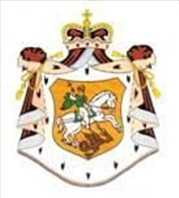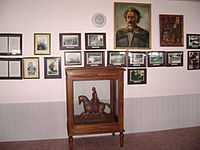Khimshiashvili





The Khimshiashvili (Georgian: ხიმშიაშვილი) was a Georgian noble family, known from the 11th century. (Their root came from a local chief in eastern Georgia: Khimshia Abazasdze and his generation was called Khimshiashvili.) They were enlisted among the tavadi princely houses of Kakheti in eastern Georgia, with their kniaz title (usually translated as "prince" or "duke") recognized by the Russian Empire .[1]
A branch of the Khimshiashvili family was also active in the southern Georgian provinces and embraced Islam under the Ottoman rule in the 16th century. They remained with the title of duke [2] in Adjara and Akhaltsikhe.[3]
The Khimshiashvili of a mountainous Adjara had been powerful enough to render the Ottoman authority in the area nominal until they were overthrown in the 1840s. Of this branch, Selim-Pasha (died 1815) is remembered for his revolt against the Ottoman government, while Ahmed-Pasha (died 1836) became a prominent Ottoman commander in the Caucasus and Anatolia. Descendants of this family survive in Georgia, and essential part of dynasty (Leon Kniaz, Selim, Sherip, Ahmed Pasha's families) live in Turkey since the October Revolution.
Selimoba Festive in Adjara
Anzor Bolkvadze, Deputy Chairman of Parliament attended the Selimoba celebration.[4]
Selim Khimshiashvili was a representative of one of the influential surnames in Adjara region and he had a great authority over the Ottoman Empire. In 1802, Ottoman Emperor appointed him on the post of the Minister (Pasha) of Russia- Ottoman Affairs. Selim Khimshiashvili fought for joining the south-west Georgia that was in the frontiers of Ottomia to its motherland. In June, 3 of 1815 by the order of Ottoman Emperor they cut off his head. Selimoba is celebrated in Khulo region annually. Anzor Bolkvadze stated: "I am proud that after two centuries everyone in Khulo region remembers the name of the hero, who sacrificed himself for his motherland”.
Selim Khimshiashvili Museum in Nigazeuli
Museum was opened on 1 July 2003[5] for keep alive Adjara national hero memories and history.
The Sherip Khimshiashvili Museum
The house museum is located in the Skhalta-Khikhani Gorge, on the left bank of the river Skhaltistskali, next to the Skhalta cathedral built at the turn of 12th to 13th centuries by Queen Tamar’s initiative.The house dates to the 19th century and belonged to Sherip Khimshiashvili
Also, Khimshiashvili family's one arm had blood relation with directly The Bagrationi (Bagration) Dynasty, most famous members are :
Khimshiashvili Family and Bagrationi Royal Dynasty Relations
Prince Aleksandri Bagrationi of Mukhrani [Kniaz Alexander Simonovitch Bagration-Mukhranski]. b. 1824. m. Princess Mariami Khimshiashvili. (b. 1843), daughter of Prince Bardzim Khimshiashvili. He d. after 1872, having had issue, three sons: [6]
(1) Prince Svimeon Bagrationi of Mukhrani "Khimshiashvili" [Kniaz Simon Alexandrovitch Bagration-Mukhranski]. b. 1855. He d. young? [6]
(2) Prince Nikolaoz Bagrationi of Mukhrani "Khimshiashvili" [Kniaz Nikolai Alexandrovitch Bagration-Mukhranski]. b. 1862. He d. young? [6]
(3) Prince Aleksandri Bagrationi of Mukhrani "Khimshiashvili" [Kniaz Alexander Alexandrovitch Bagration-Mukhranski]. b. 1864. m. Princess Evfemia (b. 1866; d. after 1931), daughter of Levan Tulashvili. He d. 1897,[6]
Khimshiashvili Family & Empress Maria Feodorovna Dagmar of Denmark
.jpg)
Maria Feodorovna was relative with one of Georgian Noble and Strong Family which were called Khimshiashvili[7] Dynasty "Tavadi (as Prince in English) of Adjara and Kakheti. Sherip Khimshiashvili Pashas( who was GrandSon of Selim Pasha) and 4 German wives graves were made by Maria Fyodorovna, the Emperor Alexander III‘s wife who was the daughter of her Uncle of Sherip’s wife.[7]
References
- ↑ Toumanoff, Cyril (1967). Studies in Christian Caucasian History, p. 272. Georgetown University Press.
- ↑ http://geiiwebsite.web-prs.com/Portals/_GEII/Documents/Selimoba%20Festival_Eng.pdf
- ↑ Bagrationi, Ioane (1768-1830). Khimshiashvili (Princes of Kakheti). The Brief Description of the Georgian Noble Houses. Retrieved on January 7, 2008.
- ↑ http://www.parliament.ge/index.php?lang_id=ENG&sec_id=1323&info_id=23595
- ↑ http://adjaramuseums.ge/en/index.php?page=showmus&mid=9
- ↑ 6.0 6.1 6.2 6.3 http://www.royalark.net/Georgia/mukhran2.htm
- ↑ 7.0 7.1 http://adjaramuseums.ge/en/index.php?page=showmus&mid=11